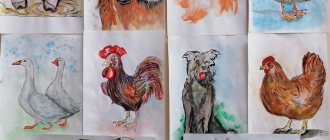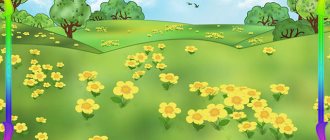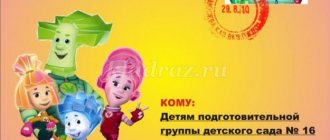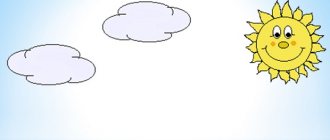Notes on FEMP in the 2nd junior group on the topic “Snowmen are visiting us”
Abstract of the GCD for FEMP in the 2nd junior group on the topic
“Snowmen are visiting us”
Purpose: To learn to compare two equal groups of objects using the method of superimposition, to understand the meaning of words in many, equally. High - low Objectives: To develop children’s ability to compare two equal groups of objects using the method of overlapping, to understand the meaning of words in many, equally. Improve knowledge about geometric shapes: circle, square, triangle.
Develop thinking, memory, cultivate perseverance, the desire to answer the teacher’s questions. Means: Toy snowman 2, one high, the other low, a picture with two Christmas trees of different sizes, 4 buckets, 4 scoops. Handout. - handout: glue stick according to the number of children, cut-out mittens according to the number of children, cut-out geometric shapes: circle, square, triangle, exceeding the number of children, napkins
Guidelines Part I. Educator.
Mystery. Red nose, a broom in his hands. Lives next to the Christmas tree. He has long been accustomed to the cold. Our cheerful..... (Snowman!) Snowmen came to visit us, look carefully and tell us, are our snowmen the same height? How are they different from each other?
Children's answers:
One is big, the other is small, tall and short, and that's right guys, they differ in height, one is tall, the other is short.
Educator:
Our snowmen brought with them pictures of Christmas trees. Are the Christmas trees in the picture the same? They brought gifts: buckets and scoops.
Let's arrange the buckets in a row. Come Roma, please arrange it. The child arranges buckets. The teacher accompanies his actions with the words: “One bucket, one more...” Educator.
How many buckets did you put?
(A lot.) Now Arseny, put one scoop in each bucket. The child completes the task, specifying the sequence of actions. Educator.
How many scoops did you put in?
(A lot.) Does each bucket have a scoop? How many buckets and scoops do we have? (A lot.) That’s right, a lot, or you could say equally. Fizminutka:
It’s frosty outside
Children slap their hands on their shoulders and stomp their feet to keep their noses from freezing. You need to stomp your feet and clap your palms. Snowflakes are falling from the sky, Children raise their hands above their heads and do as in a fairy-tale picture. grasping movements, as if catching snowflakes. We'll catch them with our hands and show them at home to mom. And there are snowdrifts around, Stretching - arms to the sides. The roads were covered with snow. Do not get stuck in the field so that, Walk in place with high knees. Raise your legs higher. We walk, walk, walk Walking in place. And we come to our house. Children take their seats
Part II. Guys, it's cold outside because what time of year?
Children
: Winter
How did we know that winter had come?
Children:
Answers
Do you like making snowmen?
Yes
Educator:
What should we do to prevent our hands from freezing when we sculpt it? Wear mittens correctly.
Part III. Game exercise
Guys, look, your mittens are torn, you need to repair them urgently. Apply a patch. Everyone’s patches are different; they’re geometric shapes. What kind of patch do you have, Anya? Do you have Lina? Etc. So our mittens are ready.
Now let's make a snowman.
We are making a snowman (imitation of making snowballs) from fluffy snow. Here they rolled the first ball, (bending down to “roll a ball of snow”) That’s how big it is. (they spread their arms from top to bottom through the sides) The second one is a little smaller, (the same, but spreading their arms a little smaller) The third is the head. (draw a circle in the air) The hat will be from a bucket. (they place their palms over their heads like a roof) The nose is a carrot, and the eyes are (points to the nose and eyes with a finger) Two cheerful coals. That's it, our snowman is ready, he looks happy. The mouth laughs from ear to ear, (points a finger at the mouth) He makes all the children laugh. (smile) Reflection: Guys, who came to visit us today? (snowmen) How many snowmen were there? (two) how tall are they? What gifts did the snowmen bring? (buckets and scoops) Christmas trees How many buckets and scoops were there? (a lot or equally) What we did. To make snowmen?
We made patches for the mittens. Well done guys, you did a good job. And the snowmen say goodbye to you; it’s time for them to go to the forest so as not to melt.
Program content
• Continue to teach how to compare two unequal groups of objects using the methods of superimposition and application, to denote the results of comparison with the words more - less, as much - as, equally.
• Improve the ability to distinguish and name a circle, square, triangle.
Didactic visual material
Demonstration material. Flannelograph; outline images of kittens and baskets (5 pieces each); geometric shapes of different sizes and different colors (circle, square, triangle), tray.
Handout. Double-page cards; bears and candies cut out of cardboard (5 pieces for each child); geometric shapes of different sizes and different colors (circles, squares, triangles; one for each child).
Guidelines
Part I. The teacher asks a riddle:
Soft Paws,
There are scratches on the paws.
Who came to us? (Kittens.) Let's put the kittens in baskets. (Children display baskets on a flannelgraph and put one kitten in each basket.) How many baskets do we have? How many kittens? What can you say about the number of baskets and kittens? (Children's answers.)
Look, the kittens jumped out of the baskets, and one ran away. (Places the kittens under the baskets.) Is there a kitten under each basket? (No.) What are more - baskets or kittens? (Baskets.) What are fewer—kittens or baskets? (Kittens.) How to make it so that there are equal numbers of baskets and kittens?
The children, together with the teacher, discuss options for establishing equality and make sure that there is an equal number of baskets and kittens.
Educator . How many baskets and kittens are there now? Now there are equal numbers of kittens and baskets? (Children's answers.)
Part II . The teacher reads the poem “Teddy bear…”, and the children imitate the movements of the bear.
A clubfooted bear is walking through the forest,
He collects cones and sings a song.
Suddenly a cone fell right on the bear’s forehead,
The bear got angry and kicked!
I won't go for a walk in the forest anymore!
I won't go collecting pine cones anymore!
Educator . Find the bears on your trays and place them on the top strip of the card. How many bears do you have? Let's treat them to candy.
The teacher gives the children candy (one less than the bears), which the children place on the bottom strip of the card (under each bear).
Educator. How many bears? How many candies? Does every bear have candy? What is more - bears or candies? What is less - candy or bears? How to make it so that there is an equal number of candies and bears?
Children equalize the number of candies and bears.
Part III. Outdoor game “Find the same figure.”
Geometric shapes are laid out on the carpet.
Educator. What shapes do you see? What is the difference?
The teacher invites the children to take one figure from the tray. Then the children move to the music, and at the end of the melody they find the same figures on the carpet and, together with the teacher, justify their choice.
The game is repeated 2-3 times with changing pieces.
Lesson on FEMP in kindergarten in the younger group
Lesson on FEMP in a preschool institution for younger preschoolers
Technological map of organized educational activities
Educational areas: Cognition. Communication Section : FEMP Topic: Above - below. Far - close Goal: Formation of the concept of the spatial arrangement of objects (above - below in the figure and in the immediate vicinity of oneself Objectives: 1. EDUCATIONAL: • Reinforce concepts: concepts of the spatial arrangement of objects 2. DEVELOPMENTAL: • Form attention, thinking, imagination, memory • Develop connected speech. 3.EDUCATIONAL: • Cultivate goodwill, a sense of mutual assistance. • Cultivate accuracy. Vocabulary work: Up-down, far-close Equipment, demonstration material : toy hare, picture “Wolf” and tasks on A2., multi-colored cubes of various sizes. 1. Organizational moment “Give a smile” (Children stand in a circle) All the children have gathered in a circle. I am your friend and you are my friend. Let’s hold hands tightly and smile at each other. Surprise moment - Guys, and you Do you like fairy tales? Let's remember fairy tales about animals? (Knock on the door) I'll go and see who's knocking. (The teacher brings in a little bunny) - Oh, guys, look who came to us. Yes, he's shaking all over, let's ask why? The little hare asks us to help cover him. Someone is chasing him. Let's help him hide. And we will find out who is chasing him ourselves. And now I’ll show you how. (On the board there is a drawing of a Wolf covered with tasks) To find out who is chasing our bunny, you need to open this drawing. 1. Assignment : Name geometric shapes 2. Assignment (“Top-bottom, left-right”) Look at the picture. Tell us who is where? (Answer: The boy is above and the girl is below. The boy is on the left and the girl is on the right)
Physical exercise I will blow high (raise my arms up) I will blow low (put my hands down) I will blow far (extend my arms in front of me) I will blow close (put my hands on my chest) (blow). 3. Task. Game-task. “Find such a cube” among other cubes identical in size but different in color. Individual work Lera, what do you see in the picture? (Answer: a boy and a girl) Where is the boy? (Answer: far) Artem, what do you see in the picture? (Answer: a boy and a girl) Where is the girl? (Answer: close)
3.Task Work in a notebook. “Help the hedgehog” - Guys, if we help the hedgehog, we will find out who scared our bunny after all.
Reflective-corrective stage: the teacher creates a situation of success for all children. He thanks him for participating in the lesson, says that the children pleased him with their actions, answers and desire to help the bunny (notes especially diligent children). Addresses the children with the question: “What was interesting for you in class today, what did you remember, what would you tell your mother about, etc.” For your kind hearts, for your efforts, for your desire to help and not leave you in trouble - accept a surprise from the bunny. (children receive stickers with images of bunnies)
We recommend watching:
GCD on FEMP in the second junior group Summary of organized educational activities on FEMP in the second junior group Synopsis of a frontal lesson on FEMP in the 2nd junior group GCD in mathematics in the 2nd junior group
Similar articles:
Math lesson notes. Theme: “One - many, big - small.” Second junior group
Math lesson notes. Topic: "Circle". Second junior group
Summary of a lesson on FEMP in kindergarten in the second junior group. Topic: “Spatial relations”
Summary of a lesson on FEMP in kindergarten in the second junior group. Triangles
Summary of lessons in kindergarten in the younger group. Topic: “Parts of the day”




